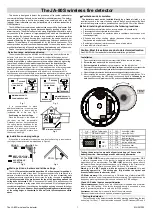
English
8
Caution: Serious trauma or fatal complications can result from failure to verify catheter
placement.
Remove the intracatheter dilators and guidewires.
D. Tunneling Retro* Catheter
Make a small incision at the exit site of the subcutaneous tunnel. The catheter is marked to
indicate a theoretical hub. This marking should be just outside the exit site. Make the incision
just wide enough to accommodate the catheter. Administer sufficient local anesthetic to
completely anesthetize the tissue.
Using blunt dissection with the tunneling stylet, create a subcutaneous tunnel directly
towards the entry site.
When the tunneling stylet emerges from the entry site, place the tapered end of the tunnel-
ing sleeve over the exposed tunneler. If necessary, push the sleeve to start a tract for the cuff
to slide through the subcutaneous tunnel.
Thread or snap the catheter adapter/tunneler onto the stylet so that it is firmly attached
(depends on which tunneler is used).
Remove the proximal clamps on the catheter and cut the catheter at the 50 cm mark on the
venous side and 47.5 cm mark on the arterial lumen.
For femoral catheters (67 cm overall length), cut the catheter at the 65 cm mark on the venous
side and 62.5 cm on the arterial lumen.
Attach the end of the catheter to the adapter, and push the tunneling sleeve over the
catheter.
Pull the tunneling stylet until the catheter is clear of the exit site and the catheter marking is
visible.
Remove the catheter carefully from the stylet by pulling the tunneling sleeve then gently
twisting the stylet out of the catheter.
Reattach the clamps to the proximal ends of the catheter.
If desired, the proximal ends of the catheter may be cut to achieve the desired length. Cuts
should be made at the marked lengths since the priming volumes for these lengths are
documented.
WARNINGS
WARNING: NEVER ATTEMPT TO SEPARATE LUMENS.
Do not tunnel through muscle.
Do not pull catheter tubing. Pulling could elongate and damage the catheter.
Do not over-expand subcutaneous tissue during tunneling. Over-expansion may delay/
prevent cuff in-growth, and can increase bleeding.
Additional blunt dissection may facilitate insertion if resistance is encountered.
IV. Femoral Vein Placement Procedure
WARNING: THE RISK OF INFECTION IS INCREASED WITH FEMORAL VEIN INSERTION. Other
access sites such as the pelvic area should be considered rather than the traditional ingui-
nal area to decrease the risk of infection.
Assess both left and right femoral areas to select the better of the two veins for catheter
placement. Use of ultrasonic visualization is recommended.
Summary of Contents for retrO
Page 107: ......









































